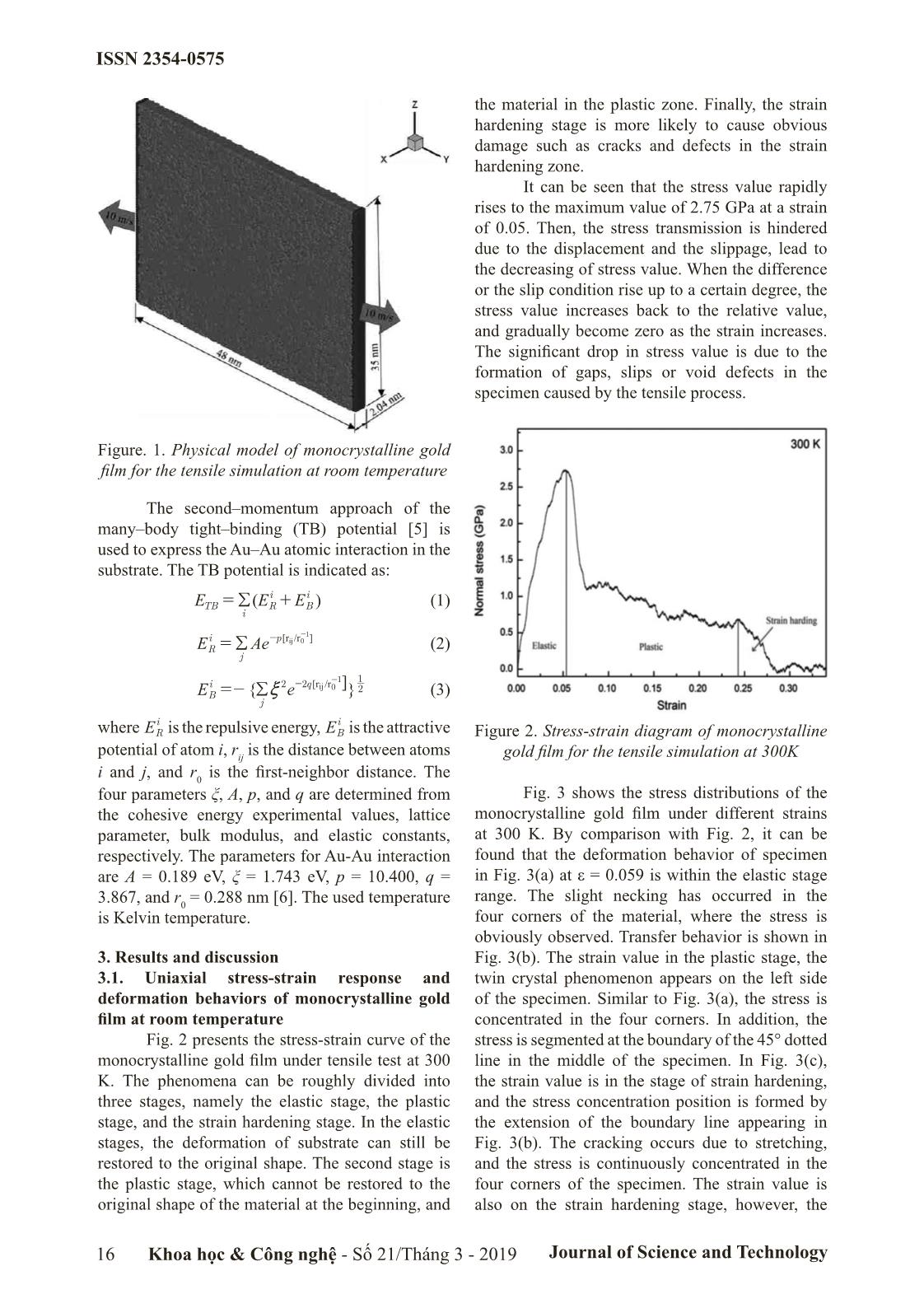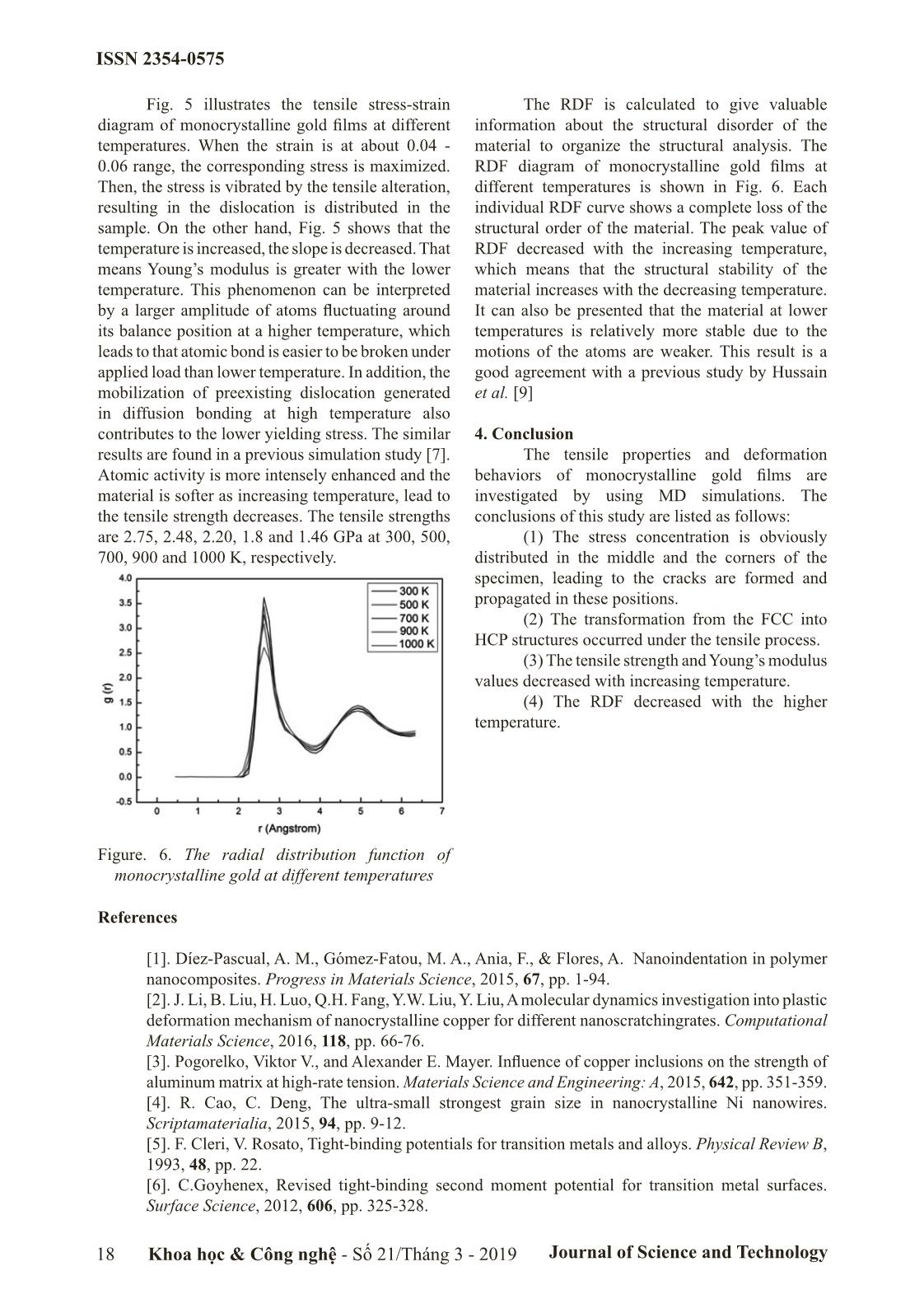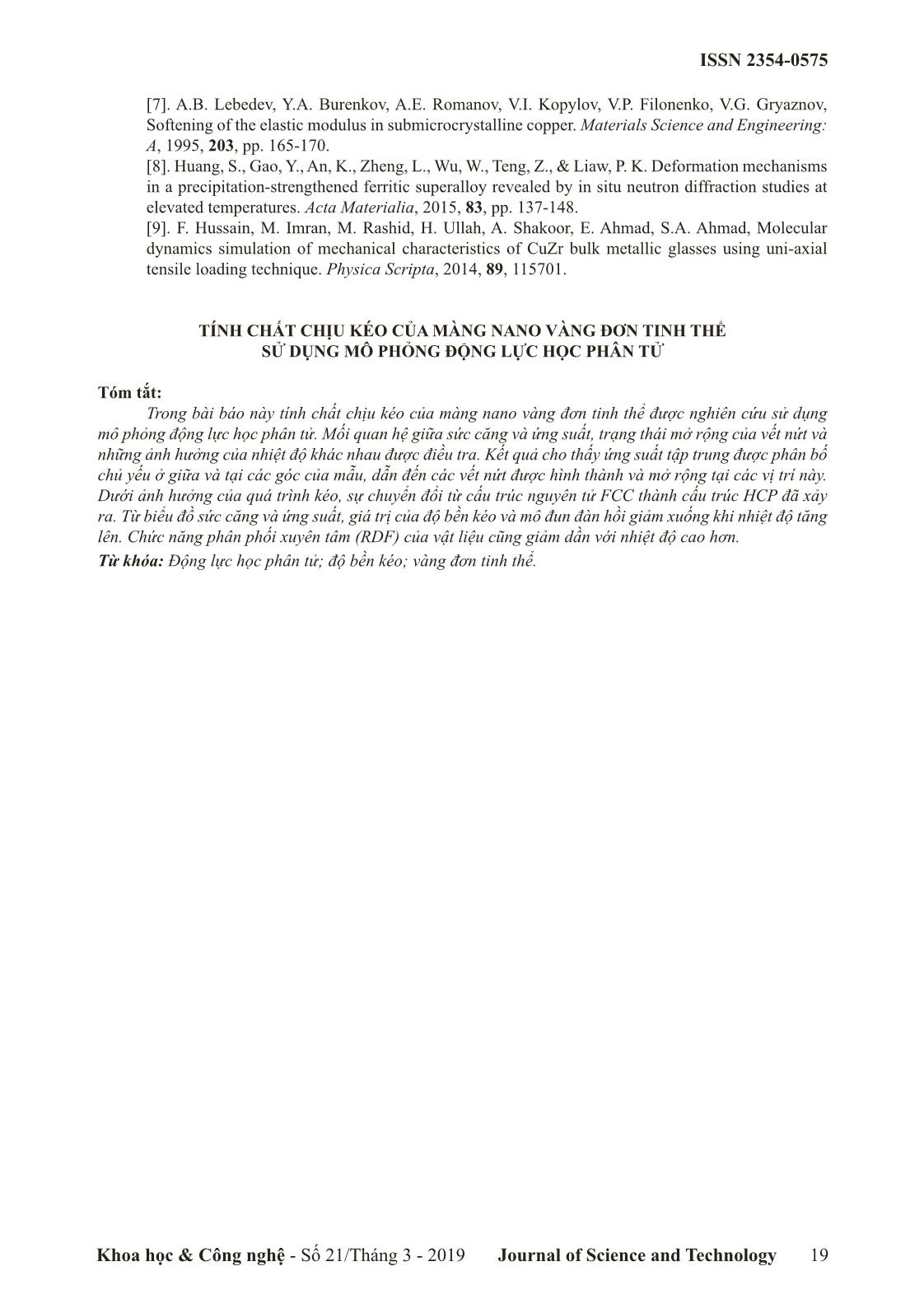Tensile properties of monocrystalline gold film using molecular dynamics simulation
In recent years, crystalline metals have
attracted intensive attention because of their
excellent mechanical properties. Many previous
studies investigated the mechanical properties
of crystalline metals by experimental methods.
However, as the size of the material decreases to
the nanoscale, the use of experimental methods is
not easy. With the rapid development of computer
technology, molecular dynamics (MD) simulations
have become more suitable than empirical methods
for studying the properties of nanomaterials.
Numerous processes have been investigated using
MD simulations, including nanoindentation [1],
nanoscratch formation [2], nanotension [3], and
nanowelding [4]. Among various test processes,
nanotension is commonly used to analyze the
deformation and mechanical properties of
nanocrystalline materials.
Crystalline gold is widely applied in
electronic industries, for instance, the fabrication
of semiconductor, superconductor are used in
electronic, optical, and magnetic applications.
Therefore, the understanding of the mechanical
properties of crystalline gold is very important and
necessary for fabrication processes.

Trang 1

Trang 2

Trang 3

Trang 4

Trang 5
Tóm tắt nội dung tài liệu: Tensile properties of monocrystalline gold film using molecular dynamics simulation

ISSN 2354-0575
TENSILE PROPERTIES OF MONOCRYSTALLINE GOLD FILM
USING MOLECULAR DYNAMICS SIMULATION
The-Van Tran, Anh-Son Tran
Hung Yen University of Technology and Education
Received: 21/01/2019
Revised: 15/02/2019
Accepted for publication: 05/03/2019
Abstract:
In this paper, the tensile properties of the monocrystalline gold film are studied by using molecular
dynamics simulation. The stress-strain relation, crack growth behavior and effects of different temperature
are considered. The results show that the stress concentration is obviously distributed in the middle and
corners of the specimen, leading to the cracks are formed and propagated in these positions. Under the
tensile process, the transformation from the face-centered cubic (FCC) into hexagonal closest packed
(HCP) structures occurred. From the stress-strain diagram, the tensile strength and Young’s modulus
values decreased with increasing temperature. The RDF is decreased with a higher temperature.
Keywords: Molecular dynamics; tensile strength; monocrystalline gold.
1. Introduction 2. Methodology
In recent years, crystalline metals have In this study, the effects of nanotension
attracted intensive attention because of their on monocrystalline gold film are studied by
excellent mechanical properties. Many previous using MD simulations. Fig. 1 shows the physical
studies investigated the mechanical properties sample of monocrystalline gold film used for the
of crystalline metals by experimental methods. tensile simulation. The crystalline unit of the face-
However, as the size of the material decreases to centered cubic (FCC) Au substrate comprises x,
the nanoscale, the use of experimental methods is y, and z-axes are directed along [100], [010], and
not easy. With the rapid development of computer [001], respectively. The geometric dimensions are
technology, molecular dynamics (MD) simulations approximately 2.04 nm (width) × 48 nm (length)
have become more suitable than empirical methods × 35 nm (height). The two-dimensional (2-D)
for studying the properties of nanomaterials. nanocrystalline nanomaterials are simulated in this
Numerous processes have been investigated using study. In a real situation, 2-D nanomaterials can be
MD simulations, including nanoindentation [1], patterned with different features at various scales.
nanoscratch formation [2], nanotension [3], and These 2-D patterns have different geometries from
nanowelding [4]. Among various test processes, three-dimensional (3-D) bulk nanomaterials. The
nanotension is commonly used to analyze the 2-D model has been selected because it is simple
deformation and mechanical properties of and nanofilms can be patterned. 2-D numerical
nanocrystalline materials. models can be used with good accuracy instead of
Crystalline gold is widely applied in 3-D models if the in-plane stresses are primarily of
electronic industries, for instance, the fabrication interest. It is expected to adequate for a qualitative
of semiconductor, superconductor are used in investigation of the nanocrystalline films. The fixed
electronic, optical, and magnetic applications. layers at the left and right sides of the sample along
Therefore, the understanding of the mechanical the y-axis direction are set to a fixed thickness
properties of crystalline gold is very important and of 6 Å. The lattice constant of gold is 4.08 Å,
necessary for fabrication processes. the total numbers of atoms of the substrates are
In this paper, the author prepared approximate: 194,520. The periodic boundary
monocrystalline gold film and focused to investigate condition is considered along the x-axis, while the
the stress-strain relationship, deformation behaviors free-boundary condition is assigned to the z-axis.
and crack nucleation of monocrystalline gold The tensile speed of the fixed layer in the y-axis
film at room temperature. Besides, the effects of is fixed given unilaterally at 10 m/s until the set of
different temperatures on the mechanical properties steps is completed. The movement is integrated by
and the radial distribution function (RDF) of the velocity–Verlet algorithm with a time step of 2
monocrystalline gold are also considered. fs.
Khoa học & Công nghệ - Số 21/Tháng 3 - 2019 Journal of Science and Technology 15
ISSN 2354-0575
the material in the plastic zone. Finally, the strain
hardening stage is more likely to cause obvious
damage such as cracks and defects in the strain
hardening zone.
It can be seen that the stress value rapidly
rises to the maximum value of 2.75 GPa at a strain
of 0.05. Then, the stress transmission is hindered
due to the displacement and the slippage, lead to
the decreasing of stress value. When the difference
or the slip condition rise up to a certain degree, the
stress value increases back to the relative value,
and gradually become zero as the strain increases.
The significant drop in stress value is due tothe
formation of gaps, slips or void defects in the
specimen caused by the tensile process.
Figure. 1. Physical model of monocrystalline gold
film for the tensile simulation at room temperature
The second–momentum approach of the
many–body tight–binding (TB) potential [5] is
used to express the Au–Au atomic interaction in the
substrate. The TB potential is indicated as:
i i
EETB =+/ ()R EB (1)
i
-1
ip- [rij /r0 ]
EAR = / e (2)
j
-1 1
iq22- [rij/r0 ] 2
EeB =-{}/ p (3)
j
i i
where ER is the repulsive energy, EB is the attractive Figure 2. Stress-strain diagram of monocrystalline
potential of atom i, rij is the distance between atoms gold film for the tensile simulation at 300K
i and j, and r0 is the first-neighbor distance. The
four parameters ξ, A, p, and q are determined from Fig. 3 shows the stress distributions of the
the cohesive energy experimental values, lattice monocrystalline gold film under different strains
parameter, bulk modulus, and elastic constants, at 300 K. By comparison with Fig. 2, it can be
respectively. The parameters for Au-Au interaction found that the deformation behavior of specimen
are A = 0.189 eV, ξ = 1.743 eV, p = 10.400, q = in Fig. 3(a) at ε = 0.059 is within the elastic stage
range. The slight necking has occurred in the
3.867, and r0 = 0.288 nm [6]. The used temperature
is Kelvin temperature. four corners of the material, where the stress is
obviously observed. Transfer behavior is shown in
3. Results and discussion Fig. 3(b). The strain value in the plastic stage, the
3.1. Uniaxial stress-strain response and twin crystal phenomenon appears on the left side
deformation behaviors of monocrystalline gold of the specimen. Similar to Fig. 3(a), the stress is
film at room temperature concentrated in the four corners. In addition, the
Fig. 2 presents the stress-strain curve of the stress is segmented at the boundary of the 45° dotted
monocrystalline gold film under tensile test at 300 line in the middle of the specimen. In Fig. 3(c),
K. The phenomena can be roughly divided into the strain value is in the stage of strain hardening,
three stages, namely the elastic stage, the plastic and the stress concentration position is formed by
stage, and the strain hardening stage. In the elastic the extension of the boundary line appearing in
stages, the deformation of substrate can still be Fig. 3(b). The cracking occurs due to stretching,
restored to the original shape. The second stage is and the stress is continuously concentrated in the
the plastic stage, which cannot be restored to the four corners of the specimen. The strain value is
original shape of the material at the beginning, and also on the strain hardening stage, however, the
16 Khoa học & Công nghệ - Số 21/Tháng 3 - 2019 Journal of Science and Technology
ISSN 2354-0575
cracking damages from the corner and middle
of the specimen are formed due to the very high
value of intermediate stress concentration at these
positions, as shown in Fig. 3(d). Due to the high
local stress concentration in the corners and middle
of specimens, the link between atoms is weakened.
Therefore, the link breakdown occurs, leading to
the cracks are formed. Slippage also occurs in the
middle and it is a cause of cracking specimen. In
addition, near the fixed layer end on the left side of
the material, the twinning phenomenon is continued
until the end during the tensile process.
Figure 4. CNA diagrams of the monocrystalline gold
film under the tensile process at room temperature
Fig. 4(d) presents the interesting phenomena.
When the strain is 0.360, the FCC structures are
extremely changed into HCP structures (position C)
due to the slip and steering caused by the intense
tensile strain. The stresses are very high and
concentrated in this area. In addition, the material is
fractured from the intersection of the 45° boundary
line in the middle and the right fixed layer from the
corner. The vertical dislocations still exist on the
left side of the specimen (position A).
Finally, the transformation from the FCC
into HCP structures is mainly exhibited, the cracks
Figure 3. The stress distributions of the monocrystalline occurred in the middle and corner areas of the
gold film under tensile process at 300 K specimen with the increasing of strain under tensile
process.
Fig. 4 shows the common neighbor analysis
(CNA) diagrams of the monocrystalline gold film 3.2. Temperature effects
under the tensile process at 300 K. Fig. 4(a) shows Temperature is a factor that greatly influences
that the position of the slip is the same as the the deformation mechanism of the material.
position of the stress distribution, which is formed Therefore, to obviously analyze the different
from the four corners of the specimen. At a strain transitions in deformation mechanisms with
of 0.156 in Fig. 4(b), a boundary is produced along increasing temperature, the substrate temperatures
the 45° line in the middle of the material (position are respectively determined of 300, 500, 700, 900
B), which could not be easily judged in the stress and 1000 K in this study.
map, the stress transmission is less obvious. The
twin dislocation is evidently observed on the left
side of the specimen (position A), which causes
the different direction of the slippage, leading
to the obvious change can be seen in the stress
transmission. While the 45° boundary in the middle
of the specimen only cuts off the original difference,
there is no change the directionality, no obvious
change in stress transmission. The twin dislocations
are transferred into the vertical dislocations at a
strain of 0.250 in Fig. 4(c). However, the stress
transmission is still in the original direction and
did not change following the shift of the row slip.
In addition, the 45° boundary line can be clearly
seen in the middle of the specimen. The stress is Figure 5. Stress-strain diagram of monocrystalline
significantly concentrated on this line. gold films at different temperatures
Khoa học & Công nghệ - Số 21/Tháng 3 - 2019 Journal of Science and Technology 17
ISSN 2354-0575
Fig. 5 illustrates the tensile stress-strain The RDF is calculated to give valuable
diagram of monocrystalline gold films at different information about the structural disorder of the
temperatures. When the strain is at about 0.04 - material to organize the structural analysis. The
0.06 range, the corresponding stress is maximized. RDF diagram of monocrystalline gold films at
Then, the stress is vibrated by the tensile alteration, different temperatures is shown in Fig. 6. Each
resulting in the dislocation is distributed in the individual RDF curve shows a complete loss of the
sample. On the other hand, Fig. 5 shows that the structural order of the material. The peak value of
temperature is increased, the slope is decreased. That RDF decreased with the increasing temperature,
means Young’s modulus is greater with the lower which means that the structural stability of the
temperature. This phenomenon can be interpreted material increases with the decreasing temperature.
by a larger amplitude of atoms fluctuating around It can also be presented that the material at lower
its balance position at a higher temperature, which temperatures is relatively more stable due to the
leads to that atomic bond is easier to be broken under motions of the atoms are weaker. This result is a
applied load than lower temperature. In addition, the good agreement with a previous study by Hussain
mobilization of preexisting dislocation generated et al. [9]
in diffusion bonding at high temperature also
contributes to the lower yielding stress. The similar 4. Conclusion
results are found in a previous simulation study [7]. The tensile properties and deformation
Atomic activity is more intensely enhanced and the behaviors of monocrystalline gold films are
material is softer as increasing temperature, lead to investigated by using MD simulations. The
the tensile strength decreases. The tensile strengths conclusions of this study are listed as follows:
are 2.75, 2.48, 2.20, 1.8 and 1.46 GPa at 300, 500, (1) The stress concentration is obviously
700, 900 and 1000 K, respectively. distributed in the middle and the corners of the
specimen, leading to the cracks are formed and
propagated in these positions.
(2) The transformation from the FCC into
HCP structures occurred under the tensile process.
(3) The tensile strength and Young’s modulus
values decreased with increasing temperature.
(4) The RDF decreased with the higher
temperature.
Figure. 6. The radial distribution function of
monocrystalline gold at different temperatures
References
[1]. Díez-Pascual, A. M., Gómez-Fatou, M. A., Ania, F., & Flores, A. Nanoindentation in polymer
nanocomposites. Progress in Materials Science, 2015, 67, pp. 1-94.
[2]. J. Li, B. Liu, H. Luo, Q.H. Fang, Y.W. Liu, Y. Liu, A molecular dynamics investigation into plastic
deformation mechanism of nanocrystalline copper for different nanoscratchingrates. Computational
Materials Science, 2016, 118, pp. 66-76.
[3]. Pogorelko, Viktor V., and Alexander E. Mayer. Influence of copper inclusions on the strength of
aluminum matrix at high-rate tension. Materials Science and Engineering: A, 2015, 642, pp. 351-359.
[4]. R. Cao, C. Deng, The ultra-small strongest grain size in nanocrystalline Ni nanowires.
Scriptamaterialia, 2015, 94, pp. 9-12.
[5]. F. Cleri, V. Rosato, Tight-binding potentials for transition metals and alloys. Physical Review B,
1993, 48, pp. 22.
[6]. C.Goyhenex, Revised tight-binding second moment potential for transition metal surfaces.
Surface Science, 2012, 606, pp. 325-328.
18 Khoa học & Công nghệ - Số 21/Tháng 3 - 2019 Journal of Science and Technology
ISSN 2354-0575
[7]. A.B. Lebedev, Y.A. Burenkov, A.E. Romanov, V.I. Kopylov, V.P. Filonenko, V.G. Gryaznov,
Softening of the elastic modulus in submicrocrystalline copper. Materials Science and Engineering:
A, 1995, 203, pp. 165-170.
[8]. Huang, S., Gao, Y., An, K., Zheng, L., Wu, W., Teng, Z., & Liaw, P. K. Deformation mechanisms
in a precipitation-strengthened ferritic superalloy revealed by in situ neutron diffraction studies at
elevated temperatures. Acta Materialia, 2015, 83, pp. 137-148.
[9]. F. Hussain, M. Imran, M. Rashid, H. Ullah, A. Shakoor, E. Ahmad, S.A. Ahmad, Molecular
dynamics simulation of mechanical characteristics of CuZr bulk metallic glasses using uni-axial
tensile loading technique. Physica Scripta, 2014, 89, 115701.
TÍNH CHẤT CHỊU KÉO CỦA MÀNG NANO VÀNG ĐƠN TINH THỂ
SỬ DỤNG MÔ PHỎNG ĐỘNG LỰC HỌC PHÂN TỬ
Tóm tắt:
Trong bài báo này tính chất chịu kéo của màng nano vàng đơn tinh thể được nghiên cứu sử dụng
mô phỏng động lực học phân tử. Mối quan hệ giữa sức căng và ứng suất, trạng thái mở rộng của vết nứt và
những ảnh hưởng của nhiệt độ khác nhau được điều tra. Kết quả cho thấy ứng suất tập trung được phân bố
chủ yếu ở giữa và tại các góc của mẫu, dẫn đến các vết nứt được hình thành và mở rộng tại các vị trí này.
Dưới ảnh hưởng của quá trình kéo, sự chuyển đổi từ cấu trúc nguyên tử FCC thành cấu trúc HCP đã xảy
ra. Từ biểu đồ sức căng và ứng suất, giá trị của độ bền kéo và mô đun đàn hồi giảm xuống khi nhiệt độ tăng
lên. Chức năng phân phối xuyên tâm (RDF) của vật liệu cũng giảm dần với nhiệt độ cao hơn.
Từ khóa: Động lực học phân tử; độ bền kéo; vàng đơn tinh thể.
Khoa học & Công nghệ - Số 21/Tháng 3 - 2019 Journal of Science and Technology 19File đính kèm:
 tensile_properties_of_monocrystalline_gold_film_using_molecu.pdf
tensile_properties_of_monocrystalline_gold_film_using_molecu.pdf

